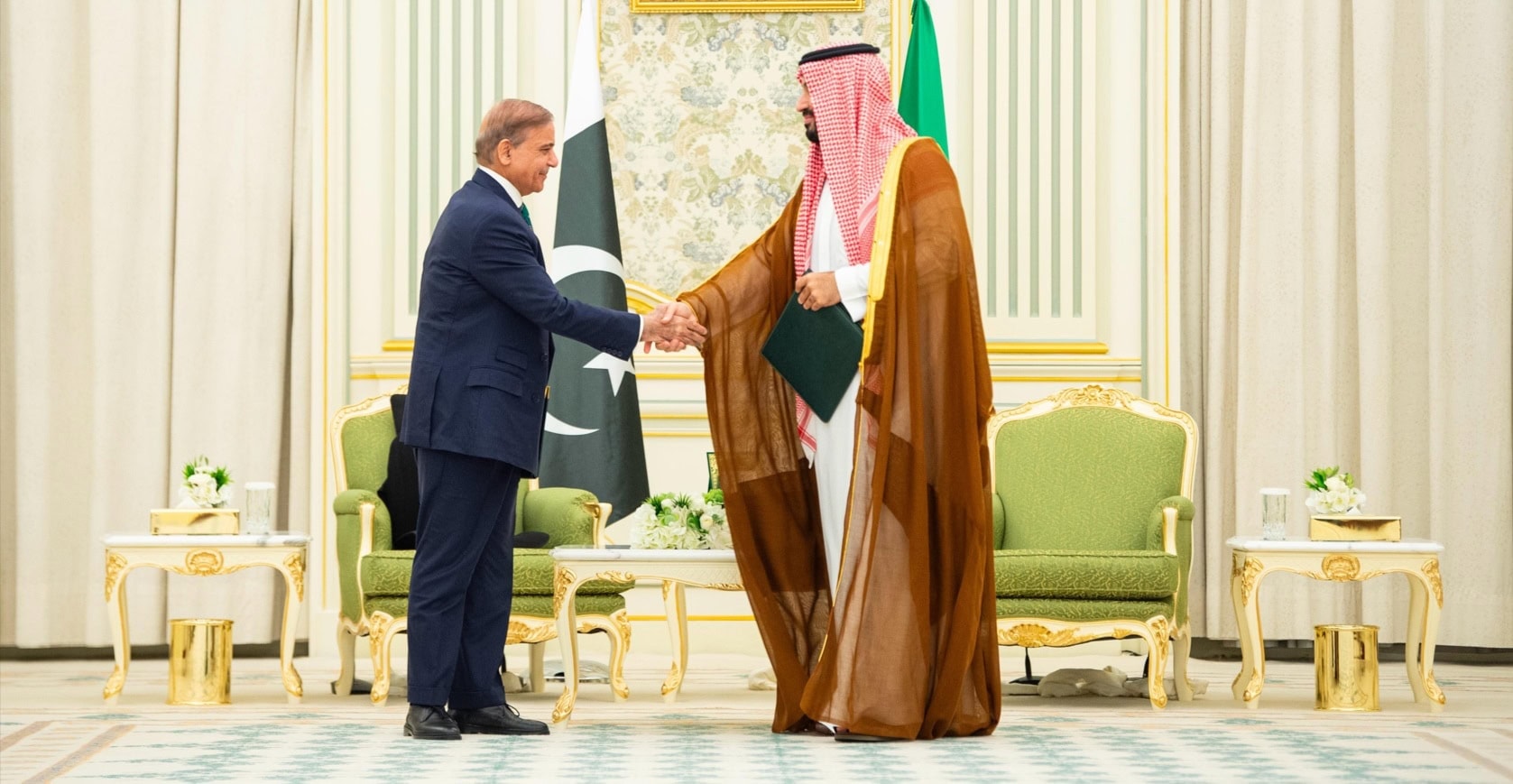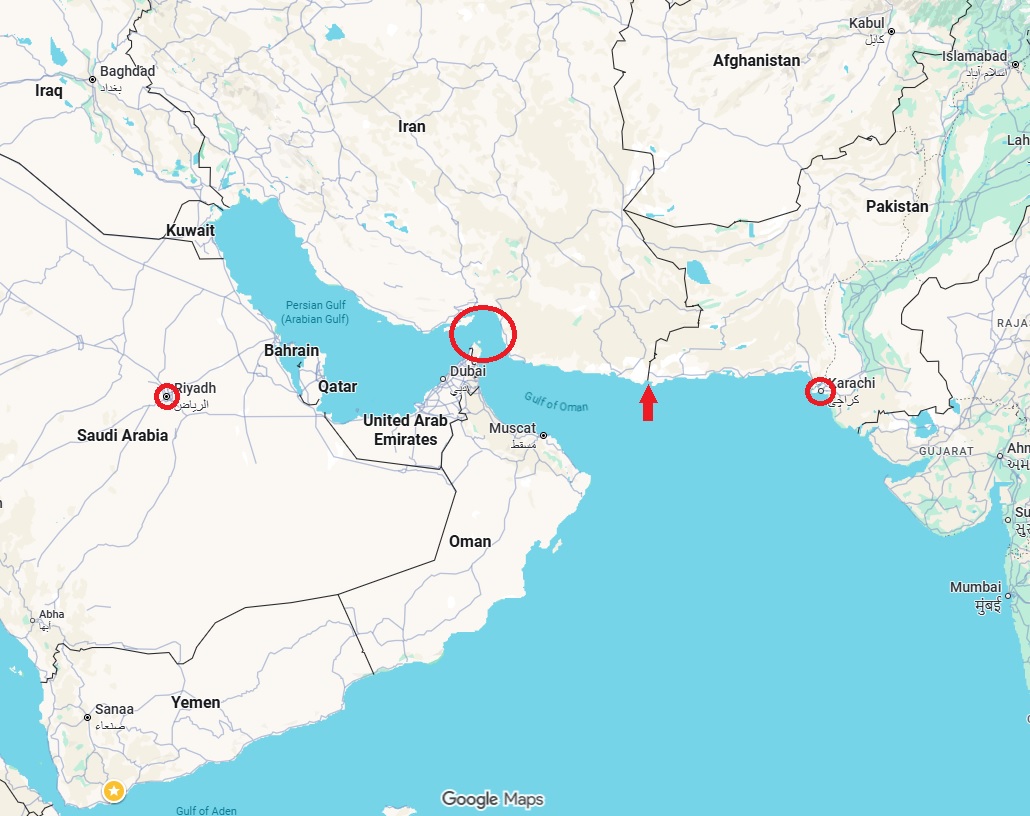
Saudi Crown Prince Mohammed bin Salman with Pakistani Prime Minister Shehbaz Sharif
02-10-2025 at 1 PM Aden Time
Farida Ahmed (South24)
The Israeli attacks on Qatar and the nature of Gulf responses to them have revealed an advanced level of collective awareness regarding the strategic risks posed by Israel’s increasingly assertive policies, which have grown bolder and now bypass international constraints through the use of military force. This structural shift in the regional security environment necessitates a radical reassessment of the security and economic balances in Gulf states. It has also deepened the sense of abandonment among traditional allies, foremost among them Saudi Arabia, especially as the United States appeared to be a mere spectator during the targeting of a Gulf state despite the presence of American military bases.
The developments since October 7, 2023, have prompted Gulf states to reconsider their security alliance map and seek more reliable strategic partnerships capable of confronting any potential aggression against their national security, amid both Israeli and Iranian threats in the region. Undoubtedly, this shift in the Gulf stance will have a direct impact on the situation in Yemen, where interests overlap and multiple local actors are involved. Hence, a central issue emerges regarding the influence of these new regional dynamics on the trajectory of the Yemeni crisis, particularly as Gulf states—bilaterally or collectively—move toward forming alternative alliances with influential international and regional powers. This analysis explores the various dimensions of these emerging alliances and their potential implications for the situation in Yemen.
Gulf Security and the Structure of New Alliances
On September 17, Saudi Arabia and Pakistan signed a “Joint Defense Agreement” aimed at enhancing military cooperation and deterrence against any mutual threat to both countries. The agreement affirmed that “any aggression against one of the two countries shall be considered an aggression against both parties.” This move cannot be viewed as a temporary bilateral accord but must be read within a historical context marked by periods of convergence and divergence in Saudi-Pakistani relations. However, its significance goes beyond historical ties, as the new alliance reflects both parties’ recognition of the global shifts in power balances and the rise of new international actors such as China, thereby reinforcing the need for broader strategic partnerships that go beyond traditional—particularly Western—frameworks.
Although many observers directly linked the announcement of the agreement to the September 9 Israeli attack on Qatar, concluding a defense deal of this magnitude typically requires years of preparation due to its sensitive nature and the numerous procedures it undergoes within the Pakistani parliament. For instance, during Operation “Decisive Storm” in 2015, Riyadh requested Islamabad to participate with ships, aircraft, and troops in the military campaign against the Houthis. However, the Pakistani parliament at the time voted in favor of a resolution rejecting direct military intervention in Yemen. What further underscores the complexity of such agreements is a statement by a senior Saudi official to Reuters, affirming that “the Saudi-Pakistani agreement is the result of years-long discussions and not a direct response to any specific party or incident.”
Beyond the debate, this defense agreement is likely to strengthen the position of the Gulf as a whole, not just Saudi Arabia. Enhancing the Kingdom’s defensive capabilities ultimately reflects on the entire Gulf system, given its military and political weight. Saudi Arabia has previously played an active role, whether during the liberation of Kuwait in 1990, or through its intervention as part of the ’Peninsula Shield Force’ to protect Bahrain during the March 2011 protests. Thanks to its strategic heft and leading role in the region, Saudi Arabia effectively positions itself as a defensive bulwark against any threat targeting a Gulf state.
Nevertheless, warnings have emerged against Arab states pursuing the protection of their self-interest without a shared Arab vision. For example, Anwar Gargash, diplomatic advisor to the UAE President, criticized—just hours before the announcement of the Saudi-Pakistani defense agreement and a day after the Arab-Islamic summit in Qatar—the absence of a “unifying Arab project”, noting that “it’s as if the message is for each party to care about its own fate alone”.
Realistically, Gulf movements can be interpreted as evidence of the absence of a unified defense project, despite the existence of the Gulf Cooperation Council, which is supposed to serve as the joint security umbrella for Gulf states. Each country now tends to formulate bilateral understandings that reflect its own priorities in the fields of security and defense. This is clearly evident in Qatar’s policy, which signed an individual military cooperation agreement with Turkey, in a path that emphasizes individual approaches at the expense of collective action. Similarly, the UAE and Bahrain proceeded to sign normalization agreements with Israel in September 2020.
The Impact of Security Shifts on the situation in Yemen
Throughout the years of conflict in Yemen since 2015, the Houthis have relied on an escalation tactic whenever they faced military pressure on the ground from other Yemeni forces backed regionally by Saudi Arabia or the UAE. When their battlefield capabilities decline and they struggle to hold out, they resort to targeting Saudi and Emirati territories with missiles and drones, in an attempt to elevate the conflict to a regional level and divert attention from themselves. Through this strategy, they have consistently exploited international reactions to create pressure on regional and local actors, pushing toward calls for a halt to the fighting and to begin negotiations, a path that allows the Houthis to regroup – which is a pattern that has repeated itself on multiple occasions.
Simultaneously, should the internationally recognized Yemeni government launch a large-scale ground offensive against the Houthis—a scenario not unlikely—the possibility of the Houthis resorting to cross-border escalation by targeting Saudi Arabia and the UAE remains high. However, the announcement of the defense agreement between Riyadh and Islamabad is likely to reduce the effectiveness of this tactical option, as the new alliance strengthens Saudi deterrence and increases the cost of any potential attack. In addition, Iran does not appear to be in a position to risk or squander what remains of its strong proxies (the Houthis) at the Bab al-Mandab Strait and the Red Sea, especially after the decline of its other regional arms, foremost among them Hezbollah.
Undoubtedly, the resumption of internal war in Yemen will place the future of the Houthis at stake, as they are likely to disintegrate both militarily and politically. On one hand, their field capabilities may be crushed by ground operations led by local forces. On the other, they face direct threats via the Red Sea from the United States and Britain, in addition to Israel, whose Defense Minister, Israel Katz, recently issued a clear threat to the Houthi group’s leader, stating that “his turn will come.”
By comparison, unlike Hezbollah’s experience, which evolved into an influential political component within Lebanon’s structure for decades, the Houthis lack the political base and institutional legitimacy required to remain a political force if militarily defeated. Their potential downfall would likely mark a complete end rather than a repositioning.
On the other hand, the threats and challenges emanating from the internationally recognized Yemeni government may reduce the Houthis’ ability to escalate retaliatorily, while Saudi Arabia will seek to ensure Iran’s neutralization and prevent it from harming either Riyadh or its allies supporting local military forces in Yemen, such as the UAE. From this perspective, it can be said that the strategic objective of the Saudi-Pakistani defense agreement appears to be a dual deterrence of both Iran and Israel. Even if Saudi Arabia presented it as a form of political maneuvering following the Israeli attack on Qatar, the practical implications suggest that countering Iran is the primary goal.
In effect, the agreement will tighten the noose around Iranian influence in the maritime corridors. Weakening or eliminating the Houthis would practically mean closing their disruptive window in the Bab al-Mandab Strait, which in turn would reduce Iranian influence in the Strait of Hormuz. Thus, it would be difficult for Tehran to accept such a double loss—first, losing its tools of influence in international shipping lanes, and second, seeing a decline in the regional sway it has built up over the years. The Pakistani dimension here is particularly significant, as its geographical location on the Gulf of Oman and the Arabian Sea, and its proximity to the Strait of Hormuz, means that any attack on Saudi oil tankers crossing the strait would be considered a direct attack on Pakistan. This gives Islamabad a strong incentive to engage in protecting oil supplies and ensuring maritime security in favor of Riyadh.

Map showing Pakistan’s proximity to the Strait of Hormuz and the Arabian Sea (Source: Google Maps – by South24 Center)
Possible Scenarios
Based on the aforementioned data, security shifts, and Gulf alliances, two main scenarios can be drawn regarding the impact of these developments on Yemen, as follows:
Scenario One: Escalation of War and Containment of the Houthis
The key factor in this trajectory is the Saudi-Pakistani defense agreement, which enhances deterrence capabilities, bolstered by parallel Gulf support evident through other regional alliance networks. Under this situation, it is likely that large-scale ground operations will be launched by Yemeni government forces backed by Saudi Arabia and the UAE, leading to a decline in the Houthis’ ability to expand the conflict. Consequently, the situation may witness a gradual disintegration of the Houthis both militarily and politically. In turn, centers of political and military gravity will shift toward local forces seeking to consolidate their influence in Houthi-controlled areas, while simultaneously securing southern Yemen. Additionally, this would also ensure security of the Bab al-Mandab Strait and Red Sea, which will serve the interests of the Gulf states and other littoral nations, as well as protect freedom of maritime navigation.
Scenario Two: Stalemate Without Military Resolution
Iran realizes that a potential loss in both the Strait of Hormuz and Bab al-Mandab would constitute an unbearable strategic double blow. This may prompt it to restrain the Houthis to avoid sliding into direct confrontation with Saudi Arabia or Pakistan. As a result, the Houthis may maintain intermittent tactical capabilities -- through missile attacks or continued use of drones across the Red Sea—just enough to assert their field presence without provoking a regional backlash that could ultimately lead to their complete annihilation. Under this equation, Yemen would enter a state of “no war, no peace,” where the conflict remains unresolved, and the Houthis persist as a weakened military force. In parallel, Saudi Arabia and the UAE may find in this phase an opportunity to reorganize their network of local alliances in Yemen, capitalizing on the period of stagnation to strengthen their influence and consolidate the presence of their allies on the ground.
In conclusion, it can be said that the future of Yemen—both in the North and the South—will remain partially contingent on the emerging regional power balances, particularly the nature of the new defense alliances. If the region moves toward escalation, Yemen may witness radical transformations that eliminate the Houthis’ presence and redraw the political and military map. However, if stagnation prevails, the country will remain trapped in a vicious cycle of attrition with no clear prospect for resolution. In both cases, Gulf states—foremost among them Saudi Arabia—will continue to play a pivotal role in shaping the trajectory of the Yemeni crisis.